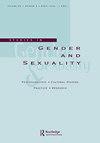"痴情女":情欲躁狂症的性别概念及其对跟踪应对措施的影响的历史概述
Q3 Social Sciences
引用次数: 0
摘要
ABSTRACT Stalking is a relatively new crime, with the U.S. state of California becoming the first jurisdiction in the world to develop specific laws about such behaviors in the early 1990s.反过来,该州(包括执法部门)转而利用现有的关于固着和痴迷行为的研究来发展类型学,以更好地理解这类犯罪行为,并以此作为应对跟踪骚扰的一种手段。本文重点介绍文献中的一种亚型,这种亚型后来被现代跟踪行为分类法所采用--即色情狂。我们探讨了色情狂的概念发展以及过去对待 "相思病 "的性别视角。我们将探讨这一视角如何影响了当代对这一病症的解释,并由此影响了在早期刑事定罪时期用于指导机构应对措施的跟踪档案中负面性别陈规定型观念的再现,甚至影响到当代的实践。本文章由计算机程序翻译,如有差异,请以英文原文为准。
“Lovesick Women”: A Historical Overview of Gendered Conceptualizations of Erotomania, and Their Influence on Responses to Stalking
ABSTRACT Stalking is a relatively new crime, with the U.S. state of California becoming the first jurisdiction in the world to develop specific laws about such behaviors in the early 1990s. In turn, the state (including law enforcement) turned to existing research on fixated and obsessed behaviors to develop typologies to better understand this kind of offending, as a means to inform response to stalking. This article focuses on one subtype featured in the literature and, later, adopted in the modern categorization of stalking behaviors—the person experiencing erotomania. We explore the conceptual development of erotomania and the gendered lens through which “lovesickness” was treated in the past. We consider how this perspective influenced contemporary constructions of the condition and, from there, influenced the reproduction of negative gender stereotypes in the stalking profiles used to guide institutional responses in the early criminalization period and, even, into contemporary practice.
求助全文
通过发布文献求助,成功后即可免费获取论文全文。
去求助
来源期刊

Studies in Gender and Sexuality
Social Sciences-Gender Studies
CiteScore
0.80
自引率
0.00%
发文量
15
期刊介绍:
Beginning in the final two decades of the 20th century, the study of gender and sexuality has been revived from a variety of directions: the traditions of feminist scholarship, postclassical and postmodern psychoanalytic theory, developmental research, and cultural studies have all contributed to renewed fascination with those powerfully formative aspects of subjectivity that fall within the rubric of "gender" and "sexuality." Clinicians, for their part, have returned to gender and sexuality with heightened sensitivity to the role of these constructs in the treatment situation, including the richly variegated ways in which assumptions about gender and sexuality enter into our understandings of "normality" and "pathology."
 求助内容:
求助内容: 应助结果提醒方式:
应助结果提醒方式:


